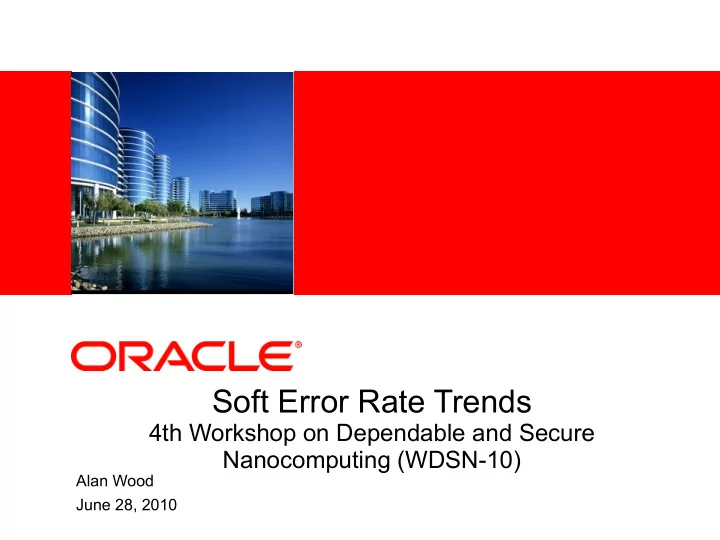

<Insert Picture Here> Soft Error Rate Trends 4th Workshop on Dependable and Secure Nanocomputing (WDSN-10) Alan Wood June 28, 2010
Shameless Advertisements • Presentation data came from the 2010 Workshop on System Effects of Logic Soft Errors (SELSE-6) • www.selse.org • Birds of a Feather session on The Future of Dependability Tuesday night, 18:00-19:30, State Room 2 WDSN-10 2
Agenda • Technology trends • Soft error rate (SER) trends • DRAM • SRAM • Logic 3 WDSN-10 3
The Largest Scale • ExaFlops supercomputer (10^18) in 2020 4 WDSN-10 4
ExaScale Computing Challenges • Energy – both for base computation and data transport • Memory and Storage – bandwidth • Concurrency and Locality – support for a billion parallel threads • Resiliency - “the ability of a system to continue operation in the presence of either faults or performance fluctuations.” • Explosive growth in component count for large systems • Advanced technology • Lower voltage levels • New classes of aging effects Source: DARPA ExaScale Computing Study 5 WDSN-10 5
Equivalent Technology Scaling “Equivalent” scaling means the number of functions doubles every 2 years (does not mean half pitch, gate length, feature size) 6 WDSN-10 6
Feature Size Scaling Feature size scaling not quite at Moore's law Source: 2009 ITRS rate but still worrisome for SER trends 7 WDSN-10 7
Servers in 2020 • Microprocessors • ~6-8nm technology (equivalent scaling) • ~128 cores per chip • ~16 Billion transistors per chip • Mostly SOCs? • CMOS replacement? • Memory • Stacked or embedded (no DIMMs) • Flash part of memory hierarchy • New technologies (PRAM, NRAM, …) 8 WDSN-10 8
Servers in 2020 - 2 • Storage • SSDs everywhere • New technology (holographic)? • Packaging • 3D • Liquid cooling • Including on-chip, e.g., heat pipes • Free-space optics? 9 WDSN-10 9
DRAM SER Trend Source: L. Borucki, G. Schindlbeck and C. Slayman, “Comparison of Accelerated DRAM Soft Error Rates Measured at Component and System Level”, IRPS, Phoenix, 2008 10 WDSN-10 10
DRAM SER Trend Explanation • DRAM memory cell SER has decreased by 2-3 orders of magnitude in the last 10 years • Memory Cells • Basic DRAM cell has not changed much, so cell capacitance has not changed much, so Qcrit has not changed much • Charge collection area decreased by a factor of 2 with each generation • DRAM Logic • Charge collection area has decreased, but decreases in voltage and different circuit designs has significantly decreased Qcrit 11 WDSN-10 11
SRAM SER Trend- Sun Source: Anand Dixit, Raymond Heald, and Alan Wood, “The Impact of New Technology on Soft Error Rates”, SELSE-6, Stanford, 2010 12 WDSN-10 12
SRAM SER Trend- AMD Source: Seth Prejean, “Accelerated Neutron Soft Error Rate Testing of AMD Microprocessors”, SELSE-6, Stanford, 2010 13 WDSN-10 13
SRAM and Logic SER Trend- Sun Source: Anand Dixit, Raymond Heald, and Alan Wood, “The Impact of New Technology on Soft Error Rates”, SELSE-6, Stanford, 2010 14 WDSN-10 14
SRAM and Logic SER Trend- AMD Source: Seth Prejean, “Accelerated Neutron Soft Error Rate Testing of AMD Microprocessors”, SELSE-6, Stanford, 2010 15 WDSN-10 15
Logic SER Trend as a Function of Voltage Source: Anand Dixit, Raymond Heald, and Alan Wood, “The Impact of New Technology on Soft Error Rates”, SELSE-6, Stanford, 2010 16 WDSN-10 16
SER Trend Explanation Source: Anand Dixit, Raymond Heald, and Alan Wood, “The Impact of New Technology on Soft Error Rates”, SELSE-6, Stanford, 2010 17 WDSN-10 17
Microprocessor SER Trend- Sun Source: Anand Dixit, Raymond Heald, and Alan Wood, “The Impact of New Technology on Soft Error Rates”, SELSE-6, Stanford, 2010 18 WDSN-10 18
Recommend
More recommend